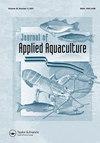坦巴基的冷、热或双重热休克:三倍体诱导、受精率、生长和血液学变量
IF 0.8
Q3 FISHERIES
引用次数: 3
摘要
本文章由计算机程序翻译,如有差异,请以英文原文为准。
Cold, heat, or double thermal shock in tambaqui (Colossoma macropomum): triploid induction, fertilization rate, growth, and hematological variables
ABSTRACT This study assessed the effectiveness of triploidy in tambaqui (Colossoma macropomum) and compared the fertilization, survival, growth performance, and hematological parameters of diploid and triploid fish. After artificial reproduction, freshly fertilized eggs were subjected to cold, heat or double thermal shock or were not exposed to the thermal shock (control group). Double thermal shock presented fertilization rate significantly lower than other treatments. Larvae submitted to cold thermal shock had a higher weight than the control and heat thermal shock treatments. The final weight of juveniles exposed to cold thermal shock was significantly higher than the other treatments with triploid induction. There was no significant difference for survival and hematological variables. The cold thermal shock produced more triploid individuals (33.33%) than the heat and double thermal shock (both 11.11%). The cold thermal shock was the most effective technique for obtaining triploid fish and it contributed to increasing the weight of tambaqui larvae.
求助全文
通过发布文献求助,成功后即可免费获取论文全文。
去求助
来源期刊

Journal of Applied Aquaculture
Environmental Science-Ecology
CiteScore
3.20
自引率
0.00%
发文量
38
期刊介绍:
The Journal of Applied Aquaculture is a platform for the sharing of practical information needed by researchers to meet the needs of investors, farm managers, extension agents and policy makers working to adapt aquaculture theory to achieve economic and food security objectives in the real world. The journal emphasizes multi-disciplinary research and case studies that propose financially and logistically viable solutions to observable problems.
 求助内容:
求助内容: 应助结果提醒方式:
应助结果提醒方式:


